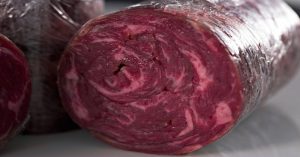
Have you ever heard the saying that a “good” lie will make it around the world while the truth is sill tying its running shoes? We’re all aware that there’s a lot of sensationalized misinformation to be found on the internet. And, for the most part such posts are aimed at attracting readers in hopes of obtaining advertising dollars. I normally just laugh off sensationalistic meat posts as not being worth my time to debunk. However, this linked video click here is currently listed as having 510K likes and is begging to be refuted for educational purposes.
Lets begin with what Greg did well to help us believe him:
1) He bills his whopper as revealing “the shocking truth.”
2) Dresses in what appears to be a BBQ restaurant uniform (conveying expert status).
3) Did not directly attack the fact that “Meat Glue” is GRAS (generally regarded as safe).
4) Insisted that he was only concerned for the children, plus didn’t want consumers to be deceived.
5) Made seemingly believable excuses as to why his restructured/sectioned & formed “rib-eye” looked so awful.
What Greg missed:
Certain raw meat proteins are salt-soluble. Other than the addition of salt, the extraction of these proteins can be further enhanced by the following: addition of polyphosphates (sodium phosphate also increases finished product moisture retention), agitation (tumbling or massaging) with resting periods of no agitation in the process, and the conducting of protein extraction in a vacuum atmosphere. Protein extracted boneless muscle cuts or chunked meats are then formed by a patty machine, stuffing into casings (usually fibrous) or formed in a rigid mold such as a loaf pan. Upon thermal processing (cooking) extracted protein coagulates thus binding products into one solid piece. This is how boneless hams are stuck back together after the femur bone is removed. Further, some boneless ham is made using the same muscle, from more than one hog, to reduce finished product muscle color variation. Fast-food type roast beef also uses salt-soluble protein technology, but since the starting beef is from tough brood cows the cooked product is sliced very thin to create the illusion of tenderness. Meat fiber strand orientation is not a deal breaker in beef, pork, chicken or turkey rolls. However, restructured pre-cooked steak items are not economically viable because of the excessive trimming and muscle fiber alignment labor required to make an eye-appealing product. And, since loin steaks are tender cuts most consumers prefer to cook them from the raw state. People eat with their eyes and will not buy strange looking Frankensteaks. Besides, it makes no sense to lop-up tender market animal loin muscles.
The one advantage meat glued product does have over protein extracted items is that the former could be sold uncooked. The high labor requirements to make an acceptable product are nearly the same in both types of meat bonding. Gluing two conical shaped tenderloin ends together (thin end to thick end) to form a uniform diameter piece is the only worth doing process I know of, and even that’s questionable since so many people like to eat steak cuts medium-rare: Intact whole muscle cuts are semi-sterile in the interior so they can safely be eaten in a somewhat less than fully-cooked state. The exterior surface of meat is exposed to environmental microorganisms. When exterior meat surfaces are glued together the new interior ethically has to be fully-cooked to ensure food safety. Given all these real world drawbacks, meat glue is currently just something that some chefs like to “create” with.
Why I thought Greg was unbelievable:
1) He was experimenting at home instead of in the Ballistic BBQ restaurant smoke-kitchen.
2) Appeared to know nothing about long used salt-soluble protein extraction technology.
3) Does not seem to realize that random meat fiber orientation absolutely leads to consumer rejection.
4) Did not know that excessive labor, in some cases excess trim loss and increased facility usage (holding under refrigeration while meat glue slowly sets up) combine to make his Frankensteak a certain economic loser.
5) I recently looked up a sous vide time estimation of 2 days at 130F to sufficiently tenderize chuck roast. The stew beef was most likely from chuck, while brisket is even tougher. Recall that Greg went 90 minutes at 130F.
6) He correctly stated that restructured meat products should be fully cooked, but failed to site any scientific reason as to how his low temperature sous vide and medium-rare grilling had achieved microbial food safety.
7) Brisket has the least saturated (softest) type of beef fat. The characteristic brisket fat appearance and mouth feel on Greg’s “rib-eye” would be another cause of consumer rejection.
8) Making excuses for the large air pockets in his product won’t make it any more salable.
9) At the part of the video where he was sampling the finished product there were 3 amateurish film cuts, this made me think he was spitting out unchewable meat.
10) It was claimed that meat glue made from hog blood might be used in the production of raw bonded Kosher meat items, but bonding tenderloin is the main semi-practical use and tenderloin comes from the Kosher off-limits hind quarter.
It looks like giving people something false to fret about is much more exciting than the boring truth.
